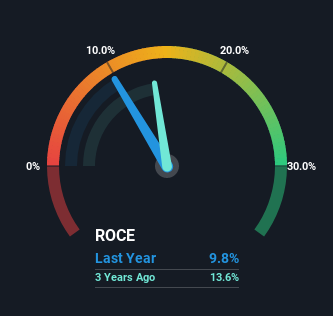Stock Analysis
- United States
- /
- Luxury
- /
- NYSE:WWW
Wolverine World Wide (NYSE:WWW) Hasn't Managed To Accelerate Its Returns

What are the early trends we should look for to identify a stock that could multiply in value over the long term? One common approach is to try and find a company with returns on capital employed (ROCE) that are increasing, in conjunction with a growing amount of capital employed. Put simply, these types of businesses are compounding machines, meaning they are continually reinvesting their earnings at ever-higher rates of return. In light of that, when we looked at Wolverine World Wide (NYSE:WWW) and its ROCE trend, we weren't exactly thrilled.
What Is Return On Capital Employed (ROCE)?
If you haven't worked with ROCE before, it measures the 'return' (pre-tax profit) a company generates from capital employed in its business. To calculate this metric for Wolverine World Wide, this is the formula:
Return on Capital Employed = Earnings Before Interest and Tax (EBIT) ÷ (Total Assets - Current Liabilities)
0.098 = US$181m ÷ (US$3.2b - US$1.3b) (Based on the trailing twelve months to October 2022).
So, Wolverine World Wide has an ROCE of 9.8%. Ultimately, that's a low return and it under-performs the Luxury industry average of 18%.
View our latest analysis for Wolverine World Wide

In the above chart we have measured Wolverine World Wide's prior ROCE against its prior performance, but the future is arguably more important. If you'd like to see what analysts are forecasting going forward, you should check out our free report for Wolverine World Wide.
What Does the ROCE Trend For Wolverine World Wide Tell Us?
There hasn't been much to report for Wolverine World Wide's returns and its level of capital employed because both metrics have been steady for the past five years. This tells us the company isn't reinvesting in itself, so it's plausible that it's past the growth phase. So don't be surprised if Wolverine World Wide doesn't end up being a multi-bagger in a few years time.
On another note, while the change in ROCE trend might not scream for attention, it's interesting that the current liabilities have actually gone up over the last five years. This is intriguing because if current liabilities hadn't increased to 42% of total assets, this reported ROCE would probably be less than9.8% because total capital employed would be higher.The 9.8% ROCE could be even lower if current liabilities weren't 42% of total assets, because the the formula would show a larger base of total capital employed. So with current liabilities at such high levels, this effectively means the likes of suppliers or short-term creditors are funding a meaningful part of the business, which in some instances can bring some risks.
The Bottom Line On Wolverine World Wide's ROCE
In a nutshell, Wolverine World Wide has been trudging along with the same returns from the same amount of capital over the last five years. And in the last five years, the stock has given away 52% so the market doesn't look too hopeful on these trends strengthening any time soon. All in all, the inherent trends aren't typical of multi-baggers, so if that's what you're after, we think you might have more luck elsewhere.
One final note, you should learn about the 4 warning signs we've spotted with Wolverine World Wide (including 2 which don't sit too well with us) .
While Wolverine World Wide isn't earning the highest return, check out this free list of companies that are earning high returns on equity with solid balance sheets.
Valuation is complex, but we're helping make it simple.
Find out whether Wolverine World Wide is potentially over or undervalued by checking out our comprehensive analysis, which includes fair value estimates, risks and warnings, dividends, insider transactions and financial health.
View the Free AnalysisHave feedback on this article? Concerned about the content? Get in touch with us directly. Alternatively, email editorial-team (at) simplywallst.com.
This article by Simply Wall St is general in nature. We provide commentary based on historical data and analyst forecasts only using an unbiased methodology and our articles are not intended to be financial advice. It does not constitute a recommendation to buy or sell any stock, and does not take account of your objectives, or your financial situation. We aim to bring you long-term focused analysis driven by fundamental data. Note that our analysis may not factor in the latest price-sensitive company announcements or qualitative material. Simply Wall St has no position in any stocks mentioned.
About NYSE:WWW
Wolverine World Wide
Designs, manufactures, sources, markets, licenses, and distributes footwear, apparel, and accessories in the United States, Europe, the Middle East, Africa, the Asia Pacific, Canada and Latin America.
Undervalued with reasonable growth potential and pays a dividend.

